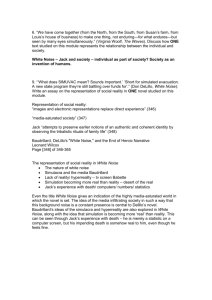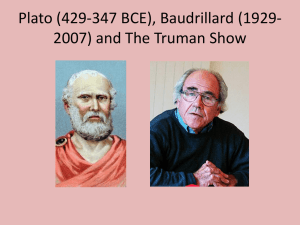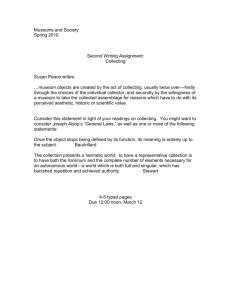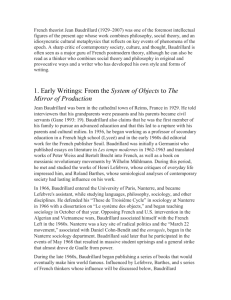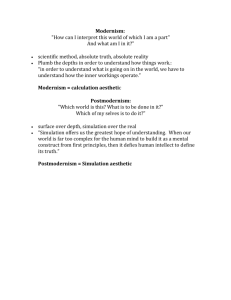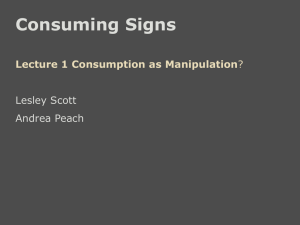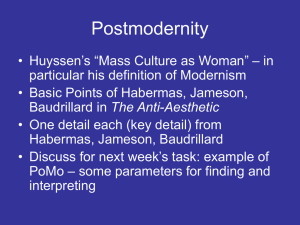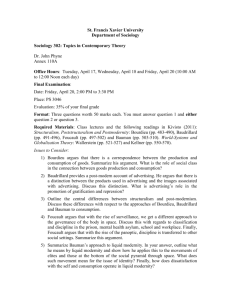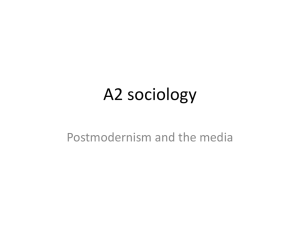HZT4UE – Theory of Knowledge
advertisement
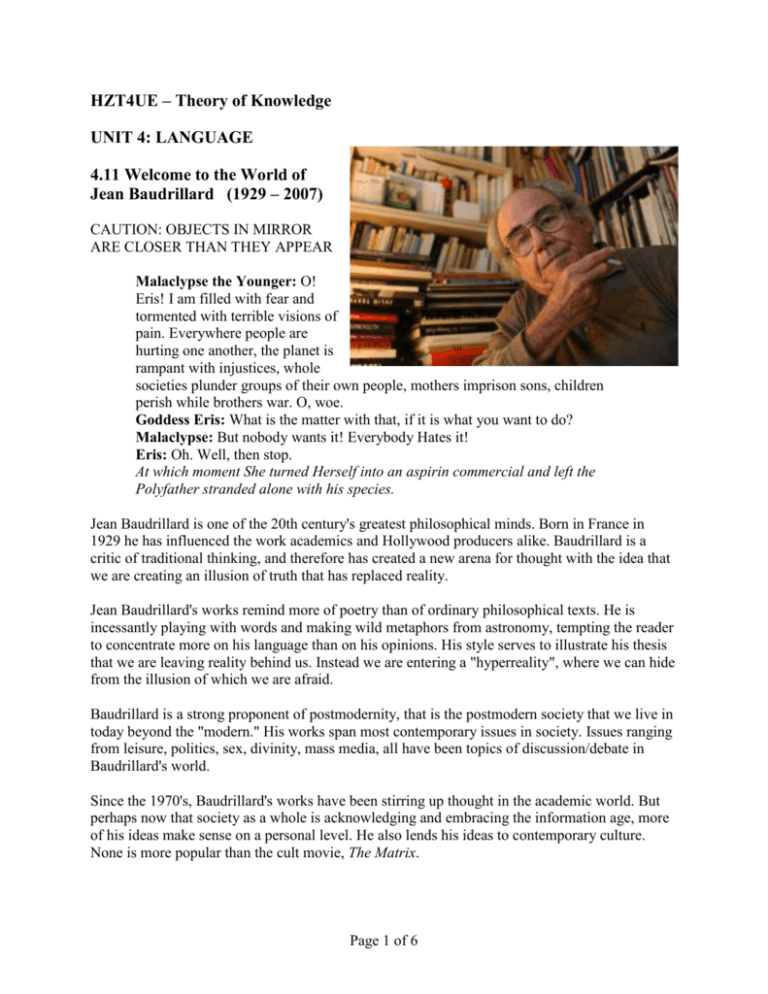
HZT4UE – Theory of Knowledge UNIT 4: LANGUAGE 4.11 Welcome to the World of Jean Baudrillard (1929 – 2007) CAUTION: OBJECTS IN MIRROR ARE CLOSER THAN THEY APPEAR Malaclypse the Younger: O! Eris! I am filled with fear and tormented with terrible visions of pain. Everywhere people are hurting one another, the planet is rampant with injustices, whole societies plunder groups of their own people, mothers imprison sons, children perish while brothers war. O, woe. Goddess Eris: What is the matter with that, if it is what you want to do? Malaclypse: But nobody wants it! Everybody Hates it! Eris: Oh. Well, then stop. At which moment She turned Herself into an aspirin commercial and left the Polyfather stranded alone with his species. Jean Baudrillard is one of the 20th century's greatest philosophical minds. Born in France in 1929 he has influenced the work academics and Hollywood producers alike. Baudrillard is a critic of traditional thinking, and therefore has created a new arena for thought with the idea that we are creating an illusion of truth that has replaced reality. Jean Baudrillard's works remind more of poetry than of ordinary philosophical texts. He is incessantly playing with words and making wild metaphors from astronomy, tempting the reader to concentrate more on his language than on his opinions. His style serves to illustrate his thesis that we are leaving reality behind us. Instead we are entering a "hyperreality", where we can hide from the illusion of which we are afraid. Baudrillard is a strong proponent of postmodernity, that is the postmodern society that we live in today beyond the "modern." His works span most contemporary issues in society. Issues ranging from leisure, politics, sex, divinity, mass media, all have been topics of discussion/debate in Baudrillard's world. Since the 1970's, Baudrillard's works have been stirring up thought in the academic world. But perhaps now that society as a whole is acknowledging and embracing the information age, more of his ideas make sense on a personal level. He also lends his ideas to contemporary culture. None is more popular than the cult movie, The Matrix. Page 1 of 6 Simulacra and Simulations (1983), by Jean Baudrillard, is the book in which Neo (Keanu Reeves) hid his diskette. I started reading it and was amazed by the relevance of the concept of the 'simulacrum' to The Matrix. A simulacrum—the copy without an original—is what the virtual world of the Matrix is symbolizing. Baudrillard states that most simulations today have been converted into a simulacrum, which no longer represents a real entity, but instead forms and defines a reality of its own, a 'hyperreality'. What we see in it is no longer an image, but something more real than its original, something that doesn't bear any relevance anymore to its real counterpart, which it once simulated. Baudrillard argues that there are four phases of the image: one that reflects a basic reality; one that masks or perverts a basic reality; one that masks the absence of a basic reality; and one that bears no relation to any reality (is its own pure simulacrum). These are seen all through society nowadays, and it seems to me that the makers of The Matrix wanted to point out that we should question and look behind the reality that 'the system' imposes on us. When Neo leaves the Matrix and is confronted with reality, he says at one time: "Get away from me. I don't believe in you." He sees the virtual reality of the Matrix as the only acceptable reality, while in fact, it is a simulacrum, to hide that nothing is there. "The simulacrum is never that which conceals the truth—it is the truth which conceals that there is none. The simulacrum is true." Baudrillard also discusses the thesis of consumer society from a neo-Marxist perspective, relying on both Lacanian psychoanalysis and Saussurean structuralism to develop his main theme, which is that consumption has become the chief basis of the social order. Consumer objects structure behavior through a linguistic sign function. Advertising has taken over "the moral responsibility for all of society and replaced a puritan morality with a hedonistic morality of pure satisfaction, like a new state of nature at the heart of hypercivilization." The freedoms and liberties we have in this new hypercivilization are completely circumscribed by the commodity system: “‘Free to be oneself’ in fact means: Free to project one's desires onto produced goods. ‘Free to enjoy life’ means: Free to regress and be irrational, and thus adapt a certain social organization of production. [This is] the ultimate in morality, since the consumer is simultaneously reconciled with himself and with the group. He becomes the perfect social being.” The relationship is similar to the Saussurean system of langue and parole: The object of consumption is a particular expression (parole) of a set of expressions that pre-exist the commodity (langue). But this is not a language: “Here we have the tower of Babel: each item speaks its own idiom.” ... People are no longer ranked according to these obsolete mechanisms but by the commodities they own—a universal code of recognition tells us that the person with the Rolex watch is higher on the hierarchy. Consumption is a “systematic act of the manipulation of signs” that signifies social status through difference—buying a Rolex means not buying a Seiko. The object itself is not consumed but rather the idea of a relation between objects. Consumption has become a kind of labour; a bricolage (Levi-Strauss) in which the individual invests his/her private world with meaning through the “active manipulation of signs.” What is consumed “is not the object itself, but the system of objects, ‘the idea of a relation’ that is Page 2 of 6 actually ‘no longer lived, but abolished, abstracted, consumed’ by the signifying system itself ... As we ‘consume’ the code, in effect, we ‘reproduce’ the system.” In this system, consumption determines one's social status: “Through objects, each individual and group searches out his-her place in an order, all the while trying to jostle this order according to a personal strategy.” In this sense there is no point in suggesting the existence of an object in and of itself because the object only has meaning as defined by the society. “The logic of exchange is primitive. In a way, the individual is nonexistent ... a certain language ... is prior to the individual. This language is a social form in relation to which there can properly speaking be no individuals, since it is an exchange structure.” The foundation of Baudrillard's philosophy is the criticism of traditional, critical scientific thinking, replacing reality with the illusion of truth. We live in an illusion, the radical illusion, where things are exactly what they seem to be. The illusion is the immediate experience one has through the five senses, a subjective experience tainted by feelings and without rationalizations. But we can't stand this complex and confused world our intuition tells us we live in, so we have started to build our own, protected world; a world we call reality. Yet it is no more real—or unreal—than the original illusion. The danger, according to Baudrillard, lies in harboring the illusion that this is truth. This is the key to his standpoint on research. The subject is not independent from the object, quite the contrary: they both influence each other. The subject influences the object through his studies and maybe, suggests Baudrillard, the object is actually manipulating the subject. Baudrillard also relates his ideas to business. The global movement of capital, that is supposed to be more real than the actual experience of the (un)employed, no longer has any connection with reality. The concept "economy" is verging on the absurd. Trade only accounts for a minimal part of the movement of capital and stock market values seem totally disconnected from real events. The absurd debts of the third world, long supposed to have to lead to a crisis, are unreal in the same way. They exist on paper, but have no manifestation in reality, since they are so ridiculously large that the countries have no way of repaying them. He also feels a simulacrum on the strictly controlled media coverage of the [1990-91 First] Gulf War. This was our first war taking place more in the media than in reality, through remotely controlled bombs and camera eyes, and is but one example of moving to the virtual reality, the reality of the media, hyperreality. Baudrillard's concept of simulation is the creation of the real through conceptual or "mythological" models which have no connection or origin in reality. The model becomes the determinant of our perception of reality—the real. Homes, relationships, fashion, art, music, all become dictated by their ideal models presented through the media. Thus the boundary between the image, or simulation, and reality implodes (breaks down). This creates a world of hyperreality where the distinctions between real and unreal are blurred. The culture industry blurs the lines between facts and information, between information and entertainment, between entertainment and politics. The masses get bombarded by these images (simulations) and signs (simulacra) which encourage them to buy, vote, work, play... but eventually they become apathetic (i.e. cynical). Because Page 3 of 6 simulations and simulacra ultimately have no referents, the social begins to implode. This process of social entropy leads to the collapse of all boundaries between meaning, the media, and the social- no distinction between classes, political parties, cultural forms, the media, and the real. Simulation and simulacra become the real so there are no stable structures on which to ground theory or politics. Culture and society become a flux of undifferentiated images and signs. Popular music provides a good example. The categories and forms of music are forced onto the musicians by music corporation's categorical conventions. They do change their categories to follow the times but the ultimate end is still restriction/conventionality. What begins as projecting a liberating function at the level of individual expression, gets turned into a repressive category. The actual musicians are turned into simulations on MTV which essentially snuff out their potential resistance to the dominant categories. They no longer have a specific historical context through which they arose. They are merely images on a screen, models to follow for other musicians if they want to get on MTV. The simulations, video images of the musicians, and audio images of the music no longer refer to a situation which brought on individual resistance/expression. For example, putting gangsta-rap music on the screen completely takes it out of its historical and social context. In this context, the art was created as an expression of resistance to the feeling of domination in urban life. When white suburban kids see the videos, they have no understanding of the actual situational context—the videos are just images on the screen like all the others images on the screen that they see everyday. This takes away the “reality” of the historical context, and replaces it with hyperreality. By removing the context, MTV removes all resistant meaning. Pop music becomes a place of one-dimensionality. In the world of hyperreality, the lines between dominance and resistance, between high and low are collapsing. There is finally no distinction. There is a unification of opposition. Pop music becomes reified. Furthermore, in a society where a constant flow of images via mass media and mass communication becomes part of everyday life, we are treated to an endless barrage of signs which we accept, not as being real, but, as Baudrillard would argue, as supplanting the real. The real loses its meaning, and what we believe and deal with are simulacra. Baudrillard would, as Jameson did, relate this idea to history. Without any grounding in the real, and having no way to prove the real, our knowledge of the past is confined to whatever symbols we associate with it when we attempt to portray it. For example, "The 1980s" as an historical entity, is not anything real, but merely the amalgamation of the symbols that we have accumulated for it, whether they be images of stonewashed designer jeans, new wave pop, breakdancing, Ronald Reagan, Just Say No, glasnost, greed, or the Challenger space shuttle explosion. There is no history, only a distorted nostalgia, distorted because it relies only on the symbols, icons, and indexes that we have access to at any given moment. Furthermore, the popularization of the portrayal of the perverse and/or unfortunate in modern media, as in, for example, the Menendez trial, the Unabomber, natural disasters, life in ghettos and third world countries,etc., can be seen as simulacra used to reinforce the existence of the Page 4 of 6 American Norm, the middle class family that is watching their television during the evening news, even though that norm does not exist. The society in the throes of postmodernism is busily involved with asserting the real, which is threatened by the predominance of simulacra. This it attempts vainly through the increasing proliferation of simulacra, divorced by definition from the real. In the constant flow of images and sound-bytes and concepts, the cultural currency in the age of information, even the idea of the real has been supplanted and subverted by its sign, hence the extreme vision of the future of postmodernism, following the lines of Baudrillard, will see simulacra replace the real entirely. We use images to lend an implicit credibility to that which has no existence in and of itself, often by using parody or contrast. The modern sitcom is the perfect example—take it in the same way Baudrillard takes Disneyland: the middle-class idyllic family doesn't exist. Not outside of TV shows like Home Improvement. A simulacra has been created, something without its own reality, a signifier without a corresponding signified, against which we judge ourselves and our own positions. This is a relatively simple simulation. But, as Baudrillard tells us, such simulations have permeated our society, which cannot itself be defined except by way of various simulacra. The social and ethnic and vocational and economic categories into which we are placed and into which we place each other and the implicit moralities and laws and rules by which we operate are all based on concepts which have no real basis, are devoid of concrete referentials. Baudrillard also speaks of desire as an instrument of power. To exhibit a desire is to crave something real, something bodily, something sensual. We cannot tell if what we desire is real— emotions are hyperreal by nature, signifiers without signified, floating concepts, possessing only illusory referentials—but we assume what we desire is real because it is so close. We perceive ourselves as real and what we desire is almost an extension of ourselves and we see what we desire as real because of that. Final Thoughts: Baudrillard was a sociologist whose deep philosophical ideas have influenced many different groups of people. His ideas of the hyperreal, that we are living in not only a postmodern society, but a simulacrum no more distinguishable than where Disneyland begins or ends. The hyperreal's grasp is far reaching and contains everything from politics, mass media, economics, religion, etc. And in this sense, society may be constricting itself into a mirror of past knowledge that will possibly not allow people as a society to grow. And although, not the entire world is plugged into the Information Age, we are all enveloped into it whether it is know or unknown. Sources (parts of all of the websites listed below): <http://www.adamranson.freeserve.co.uk/Baudrillard.html> <http://www.scholars.nus.edu.sg/cpace/theory/baudrillard/raizman.html> <http://www.uta.edu/english/hawk/semiotics/baud.htm> <http://www.csun.edu/~hfspc002/baud/> <http://cgi.student.nada.kth.se/cgi-bin/d95-aeh/get/baudrillard> Page 5 of 6 Questions on Baudrillard 1. Explain simulacrum and hyperreality by using your own words and an example of your own. 2. How does a consumer based society feed into the hyperreal? 3. What is the role of the media and internet in creating simulacra? Choose one of the examples given in the text to support your answer. 4. What does Baudrillard think has happened to History? 5. Do you think the current emphasis on 'Reality TV' programming shows frees us from the clutches of hyperreality? Explain. Page 6 of 6
